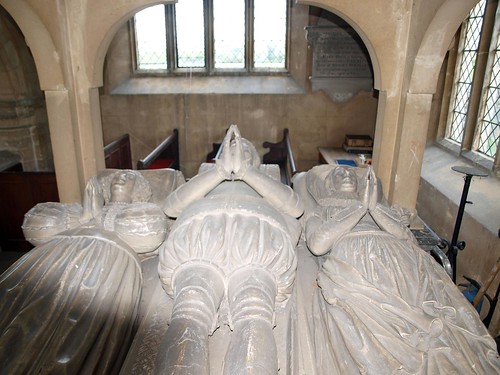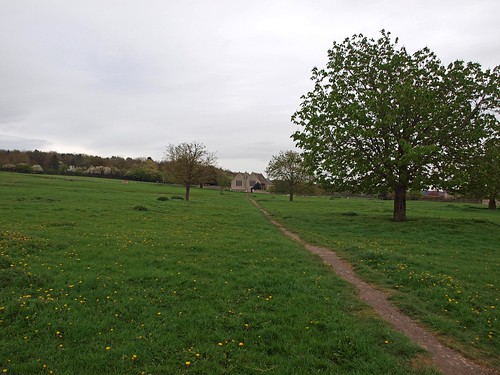The location, up a low rise in the middle of grass fields and surrounded by sheep, is stunning, the exterior attractive and the interior, with its quirky mix of Norman and C17th building, is extraordinary quite unlike any interior I've seen before. All in all very special.
ST JOHN BAPTIST. A very odd but very engaging church. Intensely domestic front. Nave and N aisle of the same width and height and with the same gables and domestic windows. The windows are straight-headed, of arched lights. A third smaller gable in the middle with a buttress up its centre. The other windows also all straight-headed. Chancel rebuilt 1842. The rest looks C17 Gothic - and such it is indeed. All the more surprising is the interior. For now we are transported into a much earlier time. The chancel arch has early C12 shafts with scalloped capitals with decoration and a C17 arch. N arcade of two bays, late C12. Shortish circular pier, square abacus. Capitals with upright leaves and crockets. Arches C17. The C17 work is connected with the erection of the MONUMENT to Sir William Dove d. 1633 and his two wives. The monument stands in the N aisle, and the aisle was rebuilt to receive the monument. The floor is raised by four steps, and the space is separated by a big classical balustrade with vertically symmetrical balusters. The monument is a four-poster. Three recumbent effigies, that of the second wife (d. 1665) in wood, i.e. made after the rest of the monument. One would like to date it from the balustrade and the big open segmental pediments as c.165-60 rather than c.1633. - COMMUNION RAIL. Jacobean with flat openwork balusters. - PULPIT. Jacobean, elaborate, with tester. - PLATE. Slender Beaker, c.1610 (German P); Paten, 1680; Cup, 1769.
UPTON. It is near Peterborough, and not to be confused with Upton by Northampton. The road runs by its thatched cottages and stops at the gate of a field in which stands a little towerless church made new in the 17th and 19th centuries. It has three gables on its west wall, the middle one for the bell, and it still admits us by a doorway through which the Normans came. We see the influence of the Normans also in the north arcade and in the chancel arch, but the capitals supporting these round arches have the stiff foliage which is the sure mark of the 13th century men.
This ancient arcade divides the nave from the Dove chapel, and its arches are filled in with a 17th century stone balustrade to form a screen. From this balustrade at one end steps lead to the great Dove Monument with classical columns and arches. It is the tomb of Sir William Dove, lord of the manor in the 17th century and son of that eloquent Bishop of Peterborough whom Queen Elizabeth used to call her Silver Dove. Sir William lies in armour between two wives, Frances in a close-fitting hood and Dorothy in a dainty embroidered gown and lace fichu, her curls clustering round her face. The figure of Dorothy, who lived on for 32 years after her husband, is believed to be the work of Nicholas Stone. A doggerel verse would have us believe there was no one like this rich Elizabethan lady.
There are Jacobean altar rails, a Jacobean table, and a little masterpiece of a pulpit made for a corner; it is set on a standard and everywhere covered with delightful panels carved with bunches of grapes. Two old candlesticks are fixed to it. The 15th century font has a carved 17th century cover.
The old manor house of the Doves is now a farmhouse, and in the orchard remains a curious sundial which Bishop Dove is said to have set up.
This ancient arcade divides the nave from the Dove chapel, and its arches are filled in with a 17th century stone balustrade to form a screen. From this balustrade at one end steps lead to the great Dove Monument with classical columns and arches. It is the tomb of Sir William Dove, lord of the manor in the 17th century and son of that eloquent Bishop of Peterborough whom Queen Elizabeth used to call her Silver Dove. Sir William lies in armour between two wives, Frances in a close-fitting hood and Dorothy in a dainty embroidered gown and lace fichu, her curls clustering round her face. The figure of Dorothy, who lived on for 32 years after her husband, is believed to be the work of Nicholas Stone. A doggerel verse would have us believe there was no one like this rich Elizabethan lady.
There are Jacobean altar rails, a Jacobean table, and a little masterpiece of a pulpit made for a corner; it is set on a standard and everywhere covered with delightful panels carved with bunches of grapes. Two old candlesticks are fixed to it. The 15th century font has a carved 17th century cover.
The old manor house of the Doves is now a farmhouse, and in the orchard remains a curious sundial which Bishop Dove is said to have set up.



No comments:
Post a Comment